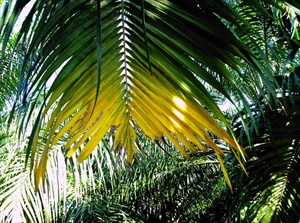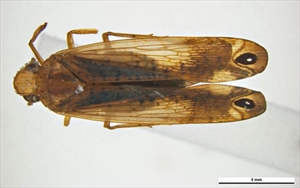Finschhafen disorder
Pacific Pests, Pathogens, Weeds & Pesticides - Online edition
Pacific Pests, Pathogens, Weeds & Pesticides
Coconut Finschhafen disorder (280)
The disorder is caused by the feeding of the leafhopper, Zophiuma butawengi (previously Zophiuma lobulata).
Reported only from Papua New Guinea in coastal areas in Morobe to Milne Bay Provinces, and in west New Britain (Map). Outbreaks were first reported on coconut in 1960 near Finschhafen and, subsequently, it was seen at Popondetta, and on Losuia island. In 1994, the disorder appeared in villages of west New Britain, and in adjacent oil palms; in 1998, it reappeared affecting both coconuts and oil palms over a very large area of New Britain. It now occurs widely on oil palm on that island and also on mainland Papua New Guinea.
Coconuts, oil palm and betel nut.
Finschhafen disorder causes early ageing of the leaves or fronds of coconut and oil palm. The leaflets become yellow-bronze starting at the tip and progressing back to the petiole or leaf stalk (Photo 1). This change to yellow-bronze is more pronounced in the leaflets near the tip of the leaf where the colour change is throughout the leaflet. As the colour change advances along the frond, the leaflets at the furthest end start to die from the tips.
The older fronds show symptoms first, with the disorder gradually spreading upwards. In severe cases, the fronds bend down more than is usual for those that are healthy, and they die prematurely. In coconut, nut production is low.
The disorder is due to the feeding of the planthopper, Zophiuma butawengi. It is not due to phytoplasmas, bacteria-like organisms or viruses carried by the planthopper. The disorder affects both young and old coconuts and oil palms, and when planthopper numbers are high (100 per frond) symptoms occur within 3 to 12 months. Furthermore, the disorder does not spread within the palms, i.e., it is not systemic. Symptoms on one frond do not lead to their occurrence on others. Remission of symptoms occurs when the planthoppers are removed.
Spread within plantations is slow and patchy.
The reason for the yellowing is unknown. It may be caused by the planthoppers damaging the cells as they feed or that their saliva is toxic.
Eggs, covered in a white woolly substance, are laid at the base of the petiole or on the lower surfaces of the leaflets. There are five nymph stages, lasting about 12 weeks. The nymphs have two long filaments extending from the posterior end of the abdomen. Adults are 16-18 mm, brownish, with a black spot enclosing a white spot at the end of the wings (Photos 2&3). Spread occurs by flight, and probably over long distances on the wind.
In outbreak areas, losses may be a third of the crop, with 80% of the palms affected and 10% dead. In severe cases, where 80-90% yellowing occurred and the fronds died, coconut palms drop their nuts. Although losses in oil palm have not been estimated, the disorder is considered a threat to production in Papua New Guinea, with some outbreaks in Milne Bay and the Northern Province exceeding 100 ha.
Look for lower leaves that are ageing faster than normal, becoming yellow-bronze from the ends of the leaflets towards the midrib, especially at the tips of the fronds. Look for large planthoppers, 16-18 mm long, feeding on the yellowing leaflets. Look for the distinctive spots at the end of their forewings.
NATURAL ENEMIES
Natural enemies of Zophiuma butawengi include generalist predators and wasp egg parasitoids. Field surveys showed that Parastethynium maxwelli and Ooencyrtus isabellae parasitise about 25% and 75% of the egg masses, respectively. Collections of entomopathogenuc fungi from West New Britain found that Metarhizium flavoviride var. minus killed Zophiuna butawengi significantly faster than two others tested in laboratory trials, and was considered to have potential as a biocontrol treatment.
RESISTANCE VARIETIES
There is no information of differences in tolerance to the disorder in either coconut or oil palm.
CHEMICAL CONTROL
Systemic insecticides have been used to contain outbreaks of the leafhopper in oil palm when pest injury was considered to be causing economic impact. However, the organophosphate insecticide used (methamidophos) is considered highly hazardous by the WHO, and is no longer used in Europe, the United States of America or Australia. It is likely that synthetic pyrethroids would be as effective.
____________________
When using a pesticide, always wear protective clothing and follow the instructions on the product label, such as dosage, timing of application, and pre-harvest interval. Recommendations will vary with the crop and system of cultivation. Expert advice on the most appropriate pesticides to use should always be sought from local agricultural authorities.
AUTHOR Grahame Jackson
Information from Smith ESC (1980) Zophiuma lobulata Ghauri (Homoptera: Lophopidae) and its relation to Finschhafen coconut disorder in Papua New Guinea. Papua New Guinea Agricultural Journal 31(1-4); and Gitau CW, et al. (2011) Zophiuma lobulata (Hemiptera: Lophopidae) causes Finschhafen disorder of coconut and oil palms. Annals of Applied Biology 158,139-148; and from (including map) Woruba DN, et al. (2014) Entomopathogenic fungi of the oil palm pest, Zophiuma butawengi (Fulgoromorpha: Lophopidae), and potential for use as biological control agents. Austral Entomology 53:268-274. https://www.academia.edu/11711849/Entomopathogenic_fungi_of_the_oil_palm_pest_Zophiuma_butawengi_Fulgoromorpha_Lophopidae_and_potential_for_use_as_biological_control_agents). Photos 1-3 Ken Walker (2011) Lophopid Planthopper (Zophiuma butawengi). (PaDIL - (http://www.padil.gov.au).
Produced with support from the Australian Centre for International Agricultural Research under project PC/2010/090: Strengthening integrated crop management research in the Pacific Islands in support of sustainable intensification of high-value crop production, implemented by the University of Queensland and the Secretariat of the Pacific Community.







